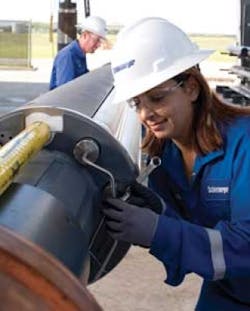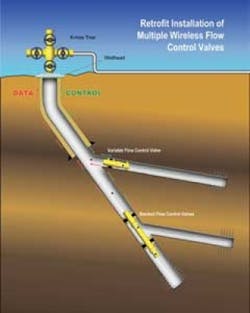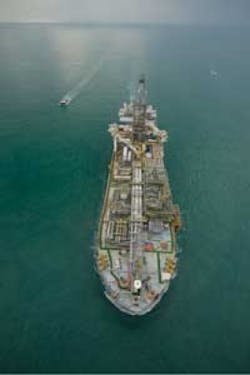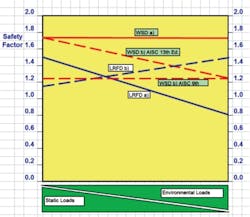New tools and technology for the offshore industry
SPE Offshore Europe 2009 showcases new technology
Despite depressed economies, SPE Offshore Europe (OE) in September drew more than 49,000 attendees, setting a new all-time record in attendance. This reflects the industry’s continuing demand for new low cost, high performance technology. Following is a sample of new products announced at this year’s show. For complete coverage from the event, please visitwww.offshore-mag.com and search “OE.”
New flow assurance simulation tool unveiled
Kongsberg Oil & Gas Technologies (KOGT) launched its next generation of multiphase flow simulation tools, called LedaFlow. The new product is the result of collaboration between Total, ConocoPhillips, Sintef, and Kongsberg.
KOGT says the new product ushers in a step-change in multiphase flow assurance technology, which has been designed for longer and larger diameter flowlines, deeper water field developments, and harsher environments. It provides 1D or quasi-3D simulation. “LedaFlow brings us closer to the actual physics,” says Kjartan Bryne Berg, manager Product & Technology for Multiphase Flow Solutions at KOGT. “It really does take multiphase flow simulation to the next level, leading to higher accuracy, better slug prediction, visualization, and well and flowline performance monitoring.”
World’s first in-riser system with SIL 2 certification released
Schlumberger released its SenTURIAN subsea landing string electrohydraulic operating system. Technological advances have resulted in an innovative, shorter modular system, which allows safe, reliable, and efficient completion installation, well cleanup, and well testing from a dynamically positioned vessel in water depths to 15,000 ft (4,572 m), Schlumberger says.
According to the company, SenTURIAN is the world’s first and only in-riser system designed and certified in accordance with the International Electrotechnical Commission’s IEC 61508 SIL 2 reliability specifications for safety related systems. IEC is the international standards and conformity assessment body for all fields of electrotechnology. In addition, the design enables compliance with ISO 13628-7 standards by providing electronic redundancy and pressure readout for each subsea function.
“The short and compact system is easy to handle and to operate, which saves rig time,” says Shehryar Lodhi, marketing manager, Schlumberger Testing Services. “It delivers reliable verification of equipment integrity and well control with state-of-the-art circuitry and accumulator technology.”
Schlumberger says SenTURIAN also is the first landing string system to use interchangeable mandrels and pressure-balanced accumulators. This allows both subsea control and accumulator modules to be combined in a single assembly, which is 50% shorter than other systems, while providing the tensile strength, pressure rating, and hydraulic output needed for operations in shallow to ultra deepwater, the company says.
The system was used in the first-ever deepwater well completed offshore India, and on a total of 28 successful completions in India and the Gulf of Mexico.
SenTURIAN operates the family of SenTREE subsea test trees, tubing hanger running tools, and completion equipment. It enables the closing of all subsea test tree valves and disconnection of a landing string in less than 15 seconds, Schlumberger says. Qualified to 275° F (135° C) and 15,000 psi (1,034 bar), the system has an interchangeable mandrel to increase the pressure rating above 15,000 psi for project specific requirements.
Improved connection reduces instrument leak probability
The instrumentation projects division of Parker Hannifin introduced a series of products to minimize potential leaks in process instrumentation.
At the core of the new equipment is the elimination of taper thread connections and associated PTFE tape or anaerobic sealant, says Parker Hannifin. The innovation lies in extending the scope of compression tube fittings throughout the instrumentation chain by integrating compression tubing ends onto valves and manifolds, the company says.
Also at the show, Parker featured its newest integrated manifold solution – the CCIMS close-coupled instrument mounting system. CCIMS provides a means to directly attach a differential pressure flow measurement instrument to a process line. Parker is now releasing CCIMS variants for differential pressure level measurement applications, and for static pressure measurement as well.
New swellable elastomer for HP/HT unveiled
Rubberatkins Ltd. unveiled a new development in swellable elastomers. Following 18 months in development, the company has developed a short swellable sealing system which is capable of holding pressures up to 10,000 psi (689 bar) and temperatures of 120º C (248º F).
“Many of the swellable elastomers that are currently on the market are not able to cope with extremely high pressures or temperatures,” says Nick Atkins, director of Rubberatkins. “The new sealing system we have developed will swell when coming into contact with oil or water, providing a simple passive sealing solution. The product has no moving parts and no special setting tools are required to put it in place, meaning that it can be deployed easily within a range of completion environments. It is possible to take this technology to withstand much higher differential pressures and temperatures which will be tested once we generate some interest.”
Rubberatkins also showcased its newly created range of high pressure, high temperature AFLAS Packer Elements, which is capable of holding pressures of up to 10,000 psi and temperatures of 450º F (232º C) continuous and 540º F (282º C) short term.
GE launches new shallow water subsea tree
GE Oil & Gas introduced the new VetcoGray SVXT S-series subsea tree. The new tree reduces weight and height by combining horizontal and vertical tree technology, says GE Oil & Gas. The pre-engineered, pre-configured modular tree system allows for installation using jackup rigs without major modifications, the company says. “Designed and manufactured in Aberdeen, Scotland, the new VetcoGray SVXT S-series subsea tree is designed for harsh, shallow waters, predominately in the North Sea but also for export globally,” says Manuel Terranova, senior VP, Subsea Production Platform, GE Oil & Gas. “The SVXT is a breakthrough in advanced pre-engineered functionality and will provide our customers with significant installation, maintenance, and cost benefits.”
Faster riser/umbilical connections
First Subsea issued details of a new diverless bend stiffener connector. The Type 2 connector eases connection of flexible risers and umbilicals in locations constrained for space, First Subsea says.
The connectors are fully self-latching, with no need for diver intervention, hydraulics or external control, and minimal ROV intervention for visual checks. These features, the company claims, lead to faster and safer installations of subsea equipment.
First Subsea’s connectors, developed with Trelleborg Offshore, can be deployed with a platform’s existing I/J tubes, with or without bellmouths, using the male connector only; or as a complete male/female unit. The design has been proven via fatigue tests witnessed by DNV.
New wireless safety valve qualified
Expro has qualified and field-trialed its FlowCAT retrofit wireless safety valve. The valve had recently completed a six-month trial in a gas well onshore southern Italy.
Expro says this marks the first use of the company’s Cableless Telemetry System (CaTS) in a flow control application.
CaTS is a development in the field of reservoir monitoring and control, allowing information to be transmitted in real time to and from downhole instruments without the use of cables. Its two-way transmission capability enables the remote control of downhole instrumentation, opening the path to the radical redesign of downhole completions, Expro says.
FlowCAT is a fail safe, closed safety valve that can be installed in the well’s existing safety valve nipple profile, or by using an alternative suspension mechanism, and is controlled from surface using the system’s electromagnetic wireless telemetry technology.
Installed in December 2008, the 4 ½-in. FlowCAT valve was deployed into the well using standard slickline intervention methods and, over the course of the six months, was cycled and inflow tested regularly during periods of both production and injection. ”Now that we have proven the reliability of the valve’s mechanical components and the robustness of the wireless telemetry scheme over an extended duration test in the onshore environment, we are working to finalize the necessary system enhancements to allow us to take the system to the offshore platform environment,” says Steve Hudson, Expro’s wireless well solutions technology manager. “We feel well placed to take it to offshore trial in the next three to six months.”
New tractor improves efficiency
Schlumberger launched its TuffTRAC cased hole services tractor. The new tractor is the industry’s shortest, and is the only tractor with full reverse and active traction control capabilities, Schlumberger says.
“TuffTRAC delivers more than 40% efficiency over conventional tractors resulting in more pushing power downhole,” says Zied Ben Hamad, marketing and technology manager, Schlumberger Wireline. “The system’s unique reversing capability reduces fishing risk and its modular design makes it easy to deploy in short rig-up situations.”
Schlumberger says it has successfully conducted field tests in North America, Europe, and the Middle East and has tractored equipment more than half a million feet in over 200 runs. The system is engineered to withstand the shock of a perforating gun detonation, and can convey any other cased hole service, the company says.
The new tractor runs on multiconductor wireline cables; the 3 1/8-in. diameter tool has a pushing capacity of 300 lb per drive section. A maximum string of six drive sections can be deployed in tandem for a tough-duty true 1,800 lb of pushing power. Active traction control provides the ability to monitor and change the pressure on each drive wheel to optimize traction in either direction.
Capable of operation to 350° F (177° C) and 20,000 psi (1,361 bar), the system’s power pack can operate without requiring cool-down periods. The tractor includes a built-in tension sub, electrical release sub, casing collar locator, addressable tractor perforating safety switch, and shock absorber.
Software tightens control of equipment tracking
Spartan Solutions launched a new system for tracking and management of equipment offshore and onshore.
The Phalanx software is designed to control and manage the movement and servicing of equipment across a company’s operations, including depots and offshore locations. It harnesses Radio Frequency IDentification (RFID) technology, barcodes, and wireless mobile computers to collect and process equipment information, removing the need for manual paper processing.
Swire Oilfield Services has deployed Phalanx for mobilization and demobilization of equipment to operations on various installations in the Norwegian North Sea. It is used for equipment tracking and search exercises, and for executing service and maintenance orders on individual pieces of equipment.
“The integrated offering is a key benefit,” says Tor Helgeland, CEO of Swire Oilfield Services. “We have been able to move the data capture to where the events are happening and reduce the risk for errors in input. The formal communication system now in place captures a complete picture of our equipment deployment and maintenance.
“We are now looking to roll out Phalanx internationally to comprehensively track the flow of equipment across various locations, including the UK, USA, and Australia, so we have a complete overview and can deliver more efficient services to our customers.”
Phalanx is fully integrated with Swire Oilfield Services’ main Enterprise Resource Planning (ERP) system. “It significantly extends the system reach so that everyone who needs to source information on a project can do so quickly and easily,” adds Helgeland
Subsea NDT system passes test offshore Australia
Applus RTD UK introduced what it claims is the world’s first subsea non-destructive testing (NDT) inspection system.
The customizable system combines ultrasonic phased array and time of flight diffraction (TOFD) techniques with alternating current field measurement (ACFM). Applus RTD tested the equipment in an application in 130 m (426 ft) of water offshore Australia, with the project being completed by an ROV using custom-designed tools.
The test focused on detailed site preparation, coating removal, inspection, and coating reinstatement at numerous locations requiring inspection for inter-granular stress corrosion cracking (IGSCC) of 12-in. (30.5-cm) 13 Chrome (13Cr) butt-welded joints.
“First and foremost, our focus was on ensuring that the test was safe and incident-free – particularly as it called for the use of new equipment and procedures, people and a considerable volume of surface deployment systems and deck operations,” says Charlie Lawther, advanced NDT manager at Applus RTD.
Prior to the inspection, the company performed various trials to determine the best way to detect IGSCC in 13Cr material. The highest detection probability for the critical internal weld root area was found to be via a combination of Phased Array and TOFD technologies.
Applus RTD’s Andy Garswood was tasked with designing and manufacturing a remote inspection tool capable of deploying the two technologies via ROV. Later in the project a request was made to include ACFM, to assist in detection of external surface discontinuities. As the scope of work increased, an ACFM probe was specially adapted to become part of the tool array.
The tooling can be deployed by virtually any make of work-class ROV, with the concept using the vessel to position the tooling as closely as possible to the weld under inspection. “Once in position, the ROV moves away and all further positioning and movement of the probe is carried out remotely from the support vessel – making the technique hugely flexible and applicable in virtually any situation if conditions permit,” says Lawther.
“The tooling worked perfectly, first time and the employment of ROV-deployed tooling enabled twice as many welds to be inspected for the same cost compared with a diver-led inspection campaign. The test delivered across every key area - schedule, cost, and inspection integrity. Persons on board constraints did limit the ability to carry out resource capacity offshore, but the fact that all involved were able to maintain equipment up-time was a considerable achievement.”
Air powered mini cranes for hazardous areas introduced
GGR introduced a range of compressed air powered mini cranes. The AL Series of cranes, based on the GGR AirLift spider crane range, comprises six models, and is classified to operate in hazardous Zone 1 and Zone 2 offshore and petrochemical environments.
The AL660, with a lifting capacity of 6 metric tons (6.6 tons), and the AL529, with a lifting capacity of 2.9 metric tons (3.2 tons), were on display.
The AL Series is designed for restricted access and confined working environments, and is said to be easily transportable by land, sea, and air. Additionally, all models can be dissembled into component form for helicopter transportation to remote locations, such as rigs and platforms.
New subsea sensing developments featured
Scan-Sense AS featured its subsea pressure/temperature transducer technology with its load/strain sensors to provide subsea strain measurement on applications including risers and subsea structure monitoring.
Four mechanical displacement sensors based on proven strain-gauge technology fitted to a pair of robust collars, become a key component in a riser monitoring system. Designed to be deployed at water depths of up to 4,000 m (13,123 ft) for up to three months, the package gives an accurate (1%FS) 4/20mA signal to continuously monitor the strain in subsea risers, says Scan-Sense.
MEMS Tilt Sensor launched
Colibrys presented its new MEMS Tilt Sensor designed for tilt measurement, measurement while drilling, borehole survey, and related applications.
The micro-electrical-mechanical system (MEMS) accelerometer, RS9003, features composite bias stability exceeding 600 μg and composite scale factor stability better than 500 ppm. Colibrys says the sensor also is applicable for stabilization of radars, antennas, turrets, and cameras.
“Silicon MEMS technology, offering a disruptive change in tilt sensing performance with major benefits in terms of robustness, size and weight, cost and power consumption,” says Soheil Habibi, business development manager for Colibrys inertial sensors.
Virtual testing displayed
The SimulationX Global Subsea Center highlighted its latest version of Simulation X with specific mode libraries dedicated to subsea hydraulics, electrics, and offshore handling with standard subsea component models to simply and accelerate modeling.
By applying SimulationX, any subsea and offshore system of arbitrary complexity, e.g. drilling and production systems, surface supply, undersea process technology, and seismography can be tested virtually before being put into production, says SimulationX.
The software, produced by ITI, Germany, is a standard CAE tool for modeling, simulating, and analyzing physical effects on a single platform – with ready-to-use standard libraries for 1D mechanics, 3D multi-body systems, power transmission, hydraulics, pneumatics, thermodynamics, electrics, electrical drives, magnets, as well as controls – post-processing included.
Polymer withstands aggressive environments
Aberdeen O-Rings and Seals unveiled a new explosive, decompression-resistant perfluoroelastomer, suitable for seals in aggressive, downhole, and processing applications.
Perlast G92E is designed specifically for offshore oil and gas applications. The polymer’s high fluorine content is claimed to render it inert to a wide range of liquids and gases, such as hydrogen sulfide and methane, encountered during oil and gas operations.
G92E, which is suitable for environments up to 260° C (500° F), has tested successfully in a range of high temperature, high pressure and aggressive gas conditions, including those described in NORSOK M710. Currently, it is undergoing further industry and international explosive decompression standards testing.
The new product is part of the EnDura range of elastomers, including HNBR, TFE/P, and FKM products, claimed to offer better chemical resistance than conventional explosive decompression grades. EnDura seals are suitable for applications such as sub-surface valves and pumps, compressors, and drill heads.








